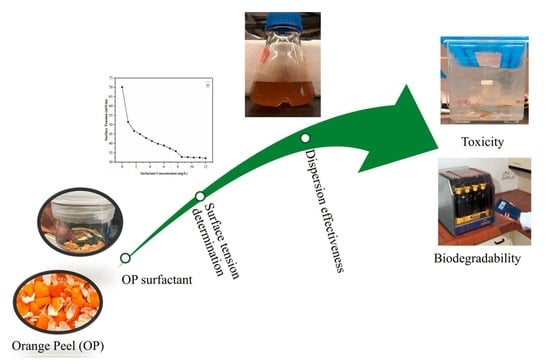Biocompatible and Biodegradable Surfactants from Orange Peel for Oil Spill Remediation
Abstract
:1. Introduction
2. Results
2.1. Surface Tension
2.2. Emulsion Stability
2.3. Dispersant Effectiveness
2.4. Optical Microscopy
2.5. Toxicity Evaluation
2.6. Biodegradability
3. Materials and Methods
3.1. Materials
3.2. Synthesis of Surfactants
3.2.1. Preparation of Orange Peel Powder
3.2.2. Pre-Treatment and Delignification
3.2.3. Cellulose Esterification
3.3. Characterization of Surfactants
3.3.1. Measurement of Surface Tension
3.3.2. Emulsion Stability
3.3.3. Dispersant Effectiveness
3.3.4. Optical Microscopy
3.3.5. Acute Fish Toxicity Analysis
3.3.6. Biodegradability
4. Conclusions
Supplementary Materials
Author Contributions
Funding
Institutional Review Board Statement
Informed Consent Statement
Data Availability Statement
Acknowledgments
Conflicts of Interest
Sample Availability
References
- Yu, Y.; Qi, Z.; Xiong, D.; Sun, R.; Fu, S.; Li, W. Oil dispersion and aggregation with suspended particles in a wave tank. J. Environ. Manag. 2021, 278, 111572. [Google Scholar] [CrossRef] [PubMed]
- Cakir, E.; Sevgili, C.; Fiskin, R. An analysis of severity of oil spill caused by vessel accidents. Transp. Res. Part D Transp. Environ. 2021, 90, 102662. [Google Scholar] [CrossRef]
- Yin, L.; Zhang, M.; Zhang, Y.; Qiao, F. The long-term prediction of the oil-contaminated water from the Sanchi collision in the East China Sea. Acta. Oceanol. Sin. 2018, 37, 69–72. [Google Scholar] [CrossRef]
- Alharthy, R.D.; Shafie, C.E.; Nessim, M.I.; Abdallah, R.I.; Moustafa, Y.M.; Wafeek, M.; Ismail, D.A.; Khalil, M.H.; Nagar, R.A. Enhanced Oil Spill Remediation Using Environmentally Asymmetric Dicationic Ionic Liquids: Synthesis, Characterization, and Evaluation. Separations 2023, 10, 397. [Google Scholar] [CrossRef]
- Zhu, T.; Kang, W.; Yang, H.; Li, Z.; Zhou, B.; He, Y.; Wang, J.; Aidarova, S.; Sarsenbekuly, B. Advances of microemulsion and its applications for improved oil recovery. Adv. Colloid. Interface Sci. 2022, 299, 102527. [Google Scholar] [CrossRef]
- Nazar, M.; Shah, M.U.H.; Ahmad, A.; Yahya, W.Z.N.; Goto, M.; Moniruzzaman, M. Ionic Liquid and Tween-80 Mixture as an Effective Dispersant for Oil Spills: Toxicity, Biodegradability, and Optimization. ACS Omega 2022, 7, 15751–15759. [Google Scholar] [CrossRef]
- Adofo, Y.K.; Nyankson, E.; Agyei-Tuffuor, B. Dispersants as an oil spill clean-up technique in the marine environment: A review. Heilyon 2022, 8, 10153. [Google Scholar]
- Clement, T.P.; John, G.F. A perspective on the state of Deepwater Horizon oil spill related tarball contamination and its impacts on Alabama beaches. Curr. Opin. Chem. Eng. 2022, 36, 100799. [Google Scholar]
- Dhaka, A.; Chattopadhyay, P. A review on physical remediation techniques for treatment of marine oil spills. J. Environ. Manag. 2021, 288, 112428. [Google Scholar] [CrossRef]
- Reddy, C.M.; Nalson, R.K.; Hanke, U.M.; Cui, X.; Summons, R.E.; Valentine, D.L.; Rodger, R.P.; Patino, M.L.; Niles, S.F. Synergy of analytical approaches enables a robust assessment of the Brazil mystery oil spill. Energy Fules 2022, 36, 13688–13704. [Google Scholar] [CrossRef]
- Fritt-Rasmussen, J.; Linnebjerg, J.F.; Nordam, T.; Riget, F.R.; Kristensen, P.; Skancke, J.; Wegeberg, S.; Mosbech, A.; Gustavson, K. Effects of chemical dispersants on feathers from Arctic seabirds. Mar. Pollut. Bull. 2023, 188, 114659. [Google Scholar] [CrossRef]
- Nazar, M.; Shah, M.U.H.; Yahya, W.Z.N.; Goto, M.; Moniruzzaman, M. Surface active ionic liquid and Tween-80 blend as an effective dispersant for crude oil spill remediation. Environ. Technol. Innov. 2021, 24, 101868. [Google Scholar] [CrossRef]
- Stroski, K.M.; Tomy, G.; Palace, V. The current state of knowledge for toxicity of corexit EC9500A dispersant: A review. Crit. Rev. Environ. Sci. Technol. 2019, 49, 81–103. [Google Scholar]
- Brakstad, O.G.; Lewis, A.; Beegle-Krause, C. A critical review of marine snow in the context of oil spills and oil spill dispersant treatment with focus on the Deepwater Horizon oil spill. Mar. Pollut. Bull. 2018, 135, 346–356. [Google Scholar]
- Badmus, S.O.; Amusa, H.A.; Oyehan, T.A.; Saleh, T. Environmental risks and toxicity of surfactants: Overview of analysis, assessment, and remediation techniques. Environ. Sci. Pollut. Res. 2021, 28, 62085–62104. [Google Scholar] [CrossRef]
- Scott, M.J.; Jones, N. The biodegradation of surfactants in the environment. Biochim. Biophys. Acta. Biomembr. 2000, 1508, 235–251. [Google Scholar] [CrossRef] [Green Version]
- Athas, J.C.; Jun, K.; McCafferty, C.; Owoseni, O.; John, V.T.; Raghavan, R. An effective dispersant for oil spills based on food-grade amphiphiles. Langmuir 2014, 30, 9285–9294. [Google Scholar] [CrossRef]
- Pan, H.; Sun, J.; Liu, J.; Zhang, Y.; Zhou, S. Preparation of sulfonated carbon derived from orange peel and its application in esterification. Chem. Phys. Lett. 2021, 770, 138395. [Google Scholar] [CrossRef]
- Ángel Siles López, J.; Li, Q.; Thompson, I.P. Biorefinery of waste orange peel. Crit. Rev. Biotechnol. 2010, 30, 63–69. [Google Scholar]
- Bicu, I.; Mustata, F. Cellulose extraction from orange peel using sulfite digestion reagents. Bioresour. Technol. 2011, 102, 10013–10019. [Google Scholar] [CrossRef]
- De la Torre, I.; Dominguez, M.V.; Acedos, M.G.; Esteban, J.; Santos, V.E.; Ladero, M. Utilisation/upgrading of orange peel waste from a biological biorefinery perspective. Appl. Microbiol. Biotechnol. 2019, 103, 5975–5991. [Google Scholar] [CrossRef] [PubMed]
- Murador, D.C.; Braga, A.R.; Martins, L.G.; Mercadante, A.Z.; Rosso, V. Ionic liquid associated with ultrasonic-assisted extraction: A new approach to obtain carotenoids from orange peel. Int. Food Res. J. 2019, 126, 108653. [Google Scholar]
- Liu, Y.; Liu, A.; Ibrahim, S.A.; Yang, H.; Huang, W. Isolation and characterization of microcrystalline cellulose from pomelo peel. Int. J. Biol. Macromol. 2018, 111, 717–721. [Google Scholar] [PubMed]
- Passos, H.; Freire, M.G.; Coutinho, J.A.P. Ionic liquid solutions as extractive solvents for value-added compounds from biomass. Green Chem. 2014, 16, 4786–4815. [Google Scholar]
- Ahmad, A.; Mahmood, H.; Mansor, N.; Iqbal, T.; Moniruzzaman, M. Ionic liquid assisted polyetheretherketone-multiwalled carbon nanotubes nanocomposites: An environmentally friendly approach. J. Appl. Polym. Sci. 2021, 138, 50159. [Google Scholar]
- Ahmad, A.; Mansor, N.; Mahmood, H.; Sharif, F.; Safdar, R.; Moniruzzaman, M. Evaluation thermal degradation kinetics of ionic liquid assisted polyetheretherketone-multiwalled carbon nanotubes composites. J. Appl. Polym. Sci. 2023, 140, 53647. [Google Scholar] [CrossRef]
- Li, M.; Wang, J.; Yang, Y.; Xie, G. Alkali-based pretreatments distinctively extract lignin and pectin for enhancing biomass saccharification by altering cellulose features in sugar-rich Jerusalem artichoke stem. Bioresour. Technol. 2016, 208, 31–41. [Google Scholar] [CrossRef] [Green Version]
- Wang, Y.; Wang, X.; Xie, Y.; Zhang, K. Functional nanomaterials through esterification of cellulose: A review of chemistry and application. Cellulose 2018, 25, 3703–3731. [Google Scholar]
- Torres-Valenzuela, L.S.; Ballesteros-Gómez, A.; Rubio, S. Green solvents for the extraction of high added-value compounds from agri-food waste. Food Eng. Rev. 2020, 12, 83–100. [Google Scholar]
- Chen, Z.; Zhang, J.; Xiao, P.; Tian, W.; Zhang, J. Novel thermoplastic cellulose esters containing bulky moieties and soft segments. ACS Sustain. Chem. Eng. 2018, 6, 4931–4939. [Google Scholar]
- Pillai, P.; Mandal, A. Synthesis and characterization of surface-active ionic liquids for their potential application in enhanced oil recovery. J. Mol. Liq. 2022, 345, 117900. [Google Scholar] [CrossRef]
- Dib, N.; Lepori, C.M.O.; Correar, N.M.; Silber, J.J.; Falcone, R.D.; Rio, L.G. Biocompatible solvents and ionic liquid-based surfactants as sustainable components to formulate environmentally friendly organized systems. Polymers 2021, 13, 1378. [Google Scholar] [CrossRef]
- Farahani, M.D.; Zheng, Y. The formulation, development and application of oil dispersants. J. Mar. Sci. Eng. 2022, 10, 425. [Google Scholar] [CrossRef]
- Nazar, M.; Shah, M.U.H.; Goto, M.; Yahya, W.Z.N.; Moniruzzaman, M. Synthesis and determination of Surface tension of 1-butyl-3-methylimidazolium lauroyl sarcosinate IL and Tween 80. J. Phys. Conf. Ser. 2021, 1793, 012045. [Google Scholar] [CrossRef]
- Wang, Z.; Xu, Y.; Khan, N.; Zhu, C.; Gao, V. Effects of the surfactant, polymer, and crude oil properties on the formation and stabilization of oil-based foam liquid films: Insights from the microscale. J. Mol. Liq. 2023, 373, 121194. [Google Scholar] [CrossRef]
- Katepalli, H. Formation and Stability of Emulsions: Effect of Surfactant-Particle Interactions and Particle Shape. Ph.D. Thesis, University of Rhode Island, Kingston, RI, USA, 2014. [Google Scholar]
- Siyar, M.; Lashkarbolooki, M. Evaluation of the interfacial tension of binary surfactant mixtures and crude oil using the response surface method. J. Mol. Liq. 2022, 366, 120253. [Google Scholar] [CrossRef]
- Baharuddin, S.H.; Mustahil, N.A.; Reddy, B.V.A.; Abdullah, A.A.; Mutalib, M.I.; Moniruzzaman, M. Development, formulation and optimization of a novel biocompatible ionic liquids dispersant for the effective oil spill remediation. Chemosphere 2020, 249, 126125. [Google Scholar] [CrossRef]
- Ma, H.; Xia, S.; Li, N.; Wang, T.; Zheng, W.; Yu, T.; Shu, Q.; Han, Y. Emulsifying stability and viscosity reduction for heavy crude oil in surfactant-polymer composite system. J. Mol. Liq. 2022, 362, 119713. [Google Scholar] [CrossRef]
- Afshar-Mohajer, N.; Lam, A.; Dora, L.; Katz, J.; Rule, M.; Koehler, K. Impact of dispersant on crude oil content of airborne fine particulate matter emitted from seawater after an oil spill. Chemosphere 2020, 256, 127063. [Google Scholar] [CrossRef]
- Passino, D.R.M.; Smith, S.B. Acute bioassays and hazard evaluation of representative contaminants detected in Great Lakes fish. Environ. Toxicol. Chem. 1987, 6, 901–907. [Google Scholar] [CrossRef]
- Sayyed, A.J.; Deshmukh, N.A.; Pinjari, D.V.J.C. A critical review of manufacturing processes used in regenerated cellulosic fibres: Viscose, cellulose acetate, cuprammonium, LiCl/DMAc, ionic liquids, and NMMO based lyocell. Cellulose 2019, 26, 2913–2940. [Google Scholar]
- Olsson, C.; Westman, G. Direct dissolution of cellulose: Background, means and applications. In Cellulose; IntechOpen: London, UK, 2013; Volume 10, p. 52144. [Google Scholar]
- Sayed, G.H.; Ghuiba, F.M.; Abdou, M.I.; Badr, E.A.; Tawfik, S.M.; Negm, N.A.M. Synthesis, surface and thermodynamic parameters of some biodegradable nonionic surfactants derived from tannic acid. Colloids Surf. A Physicochem. Eng. Asp. 2012, 393, 96–104. [Google Scholar] [CrossRef]
- Johnson, P.; Trybala, A.; Starov, V.; Pinfield, V.J. Effect of synthetic surfactants on the environment and the potential for substitution by biosurfactants. Adv. Colloid. Interface Sci. 2021, 288, 102340. [Google Scholar] [CrossRef] [PubMed]
- OECD. Guideline for Testing of Chemicals: Ready Biodegradability. In Google Scholar; OECD: Paris, France, 1992; p. 301. [Google Scholar]
- Brakstad, O.G.; Storseth, T.R.; Brunsvik, A.; Bonaunet, K.; Faksness, L.G. Biodegradation of oil spill dispersant surfactants in cold seawater. Chemosphere 2018, 204, 290–293. [Google Scholar] [CrossRef] [PubMed]
- Cai, Q.; Zhu, Z.; Chen, B.; Lee, K.; Nedwed, T.J.; Greer, C.; Zhang, B. A Cross-comparison of Biosurfactants as Marine Oil Spill Dispersants: Governing Factors, Synergetic Effects and Fates. J. Hazard. Mater. 2021, 416, 126122. [Google Scholar]
- Prince, R.C. Oil spill dispersants: Boon or bane? Environ. Sci. Technol. 2015, 49, 6376–6384. [Google Scholar] [CrossRef] [Green Version]
- Riehm, D.A.; Neilsen, J.E.; Bothun, G.D.; John, V.T.; Raghavan, S.R.; McCormick, A.V. Efficient dispersion of crude oil by blends of food-grade surfactants: Toward greener oil-spill treatments. Mar. Pollut. Bull. 2015, 101, 92–97. [Google Scholar] [CrossRef]
- Milotskyi, R.; Szabo, L.; Fujie, T.; Sakata, K.; Wada, N.; Takahashi, K. Low waste process of rapid cellulose transesterification using ionic liquid/DMSO mixed solvent: Towards more sustainable reaction systems. Carbohydr. Polym. 2021, 256, 117560. [Google Scholar]
- Zhou, Y.; Min, D.Y.; Wang, Z.; Yang, Y.; Kuga, S. Cellulose esterification with octanoyl chloride and its application to films and aerogels. BioResources 2014, 9, 3901–3908. [Google Scholar] [CrossRef]
- Xiong, Y.; Li, F.; Chen, Z.; Qin, Z. Zebrafish larvae acute toxicity test: A promising alternative to the fish acute toxicity test. Aquat. Toxicol. 2022, 246, 106143. [Google Scholar] [CrossRef]

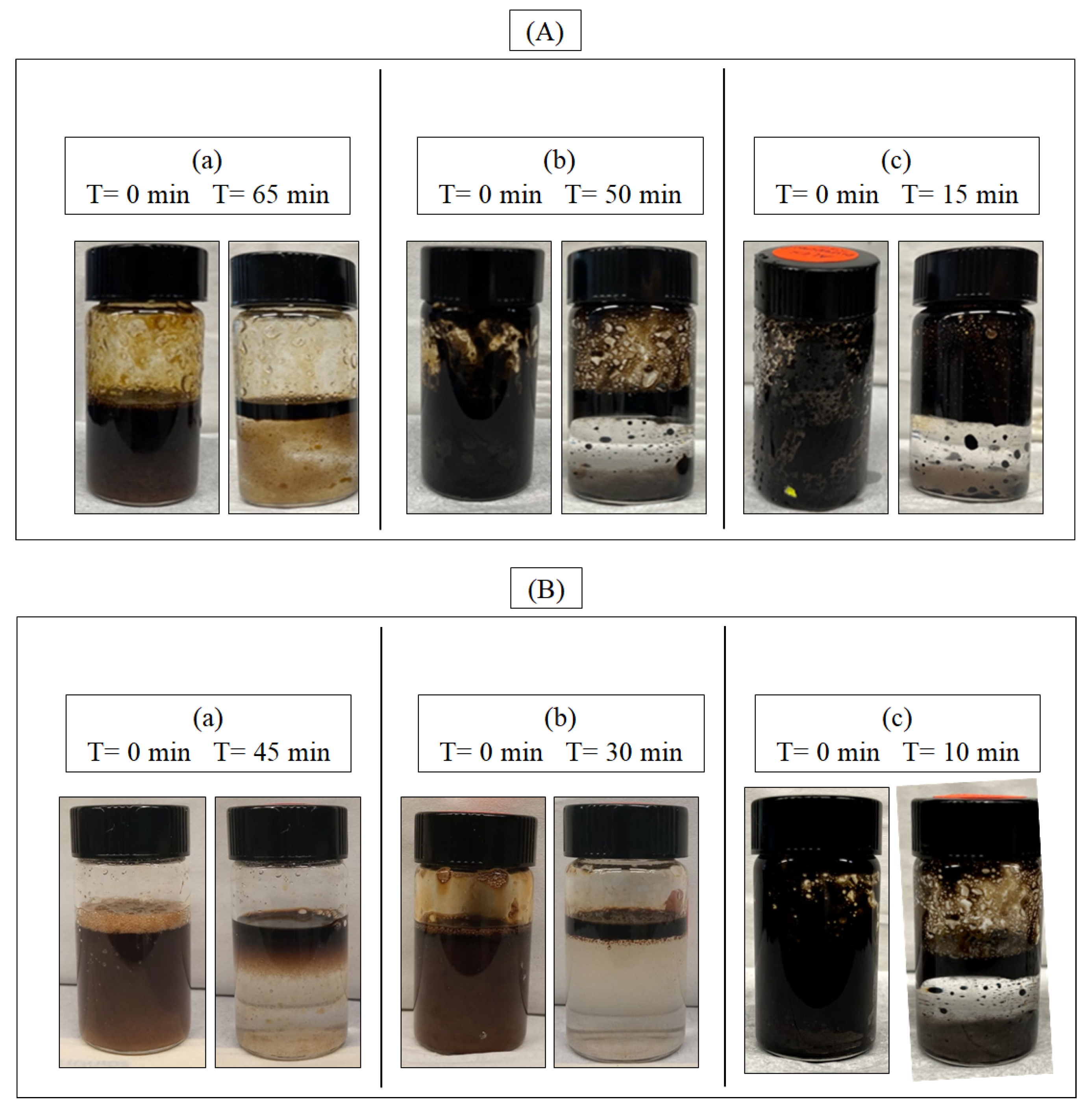
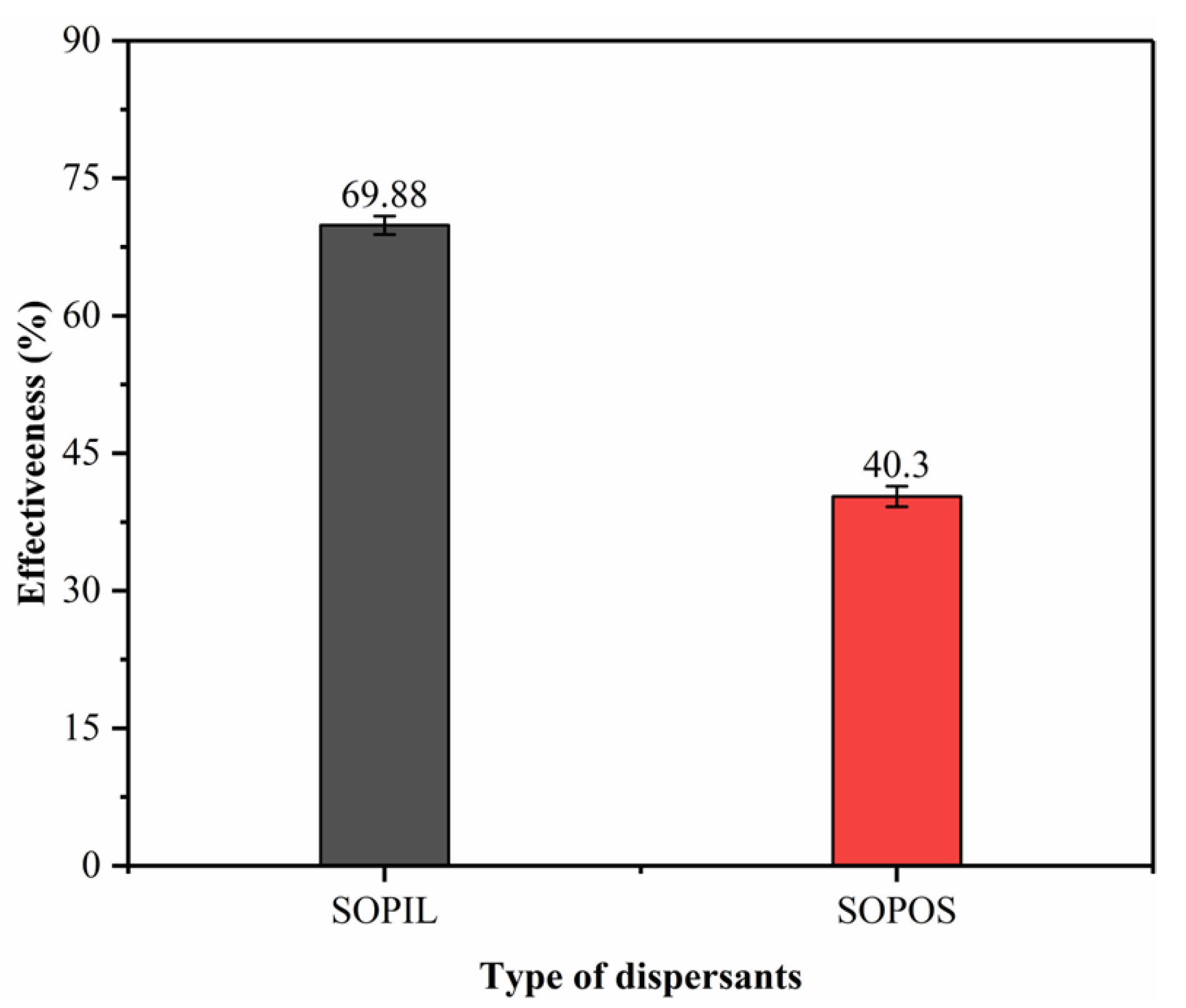
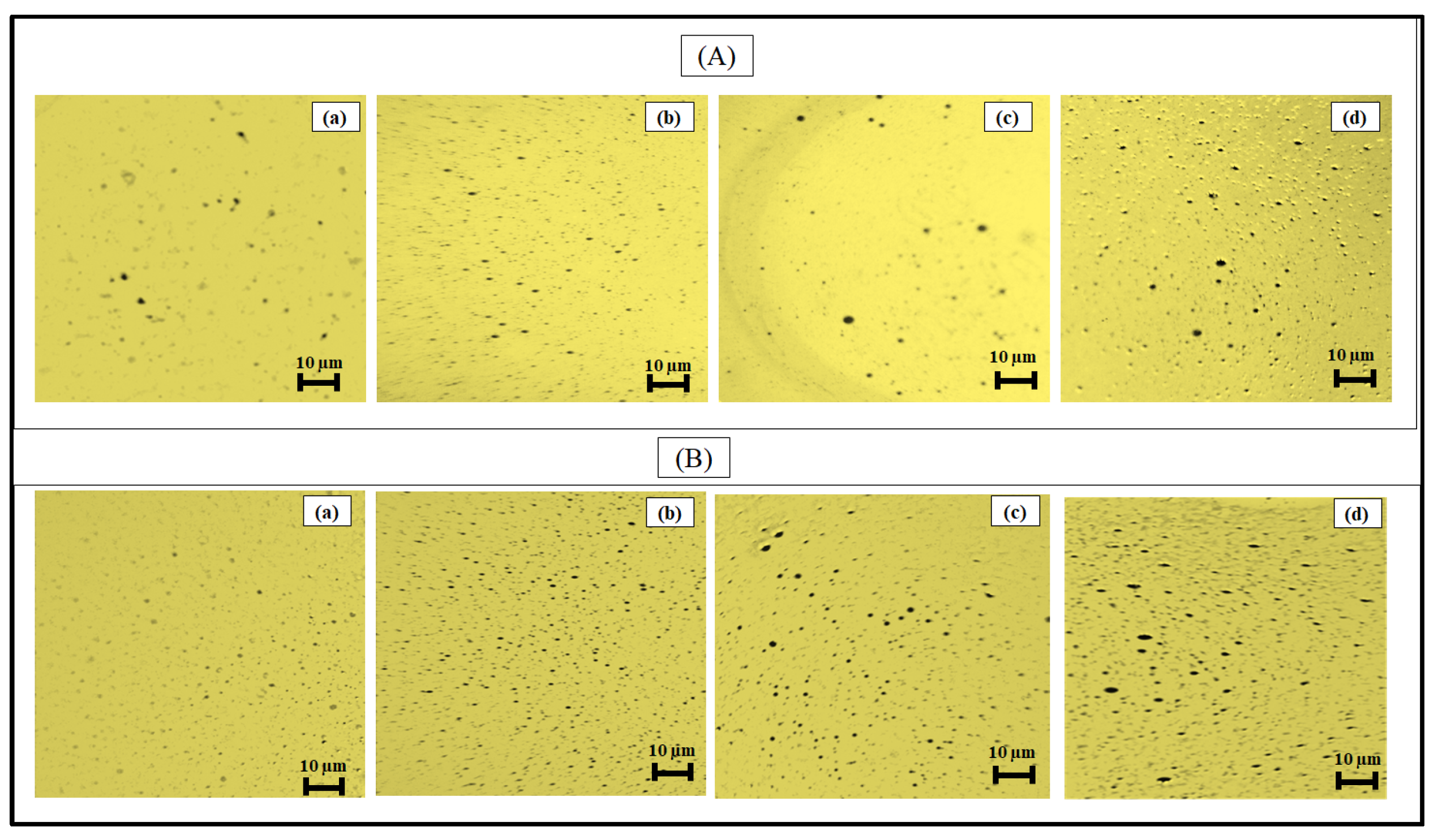
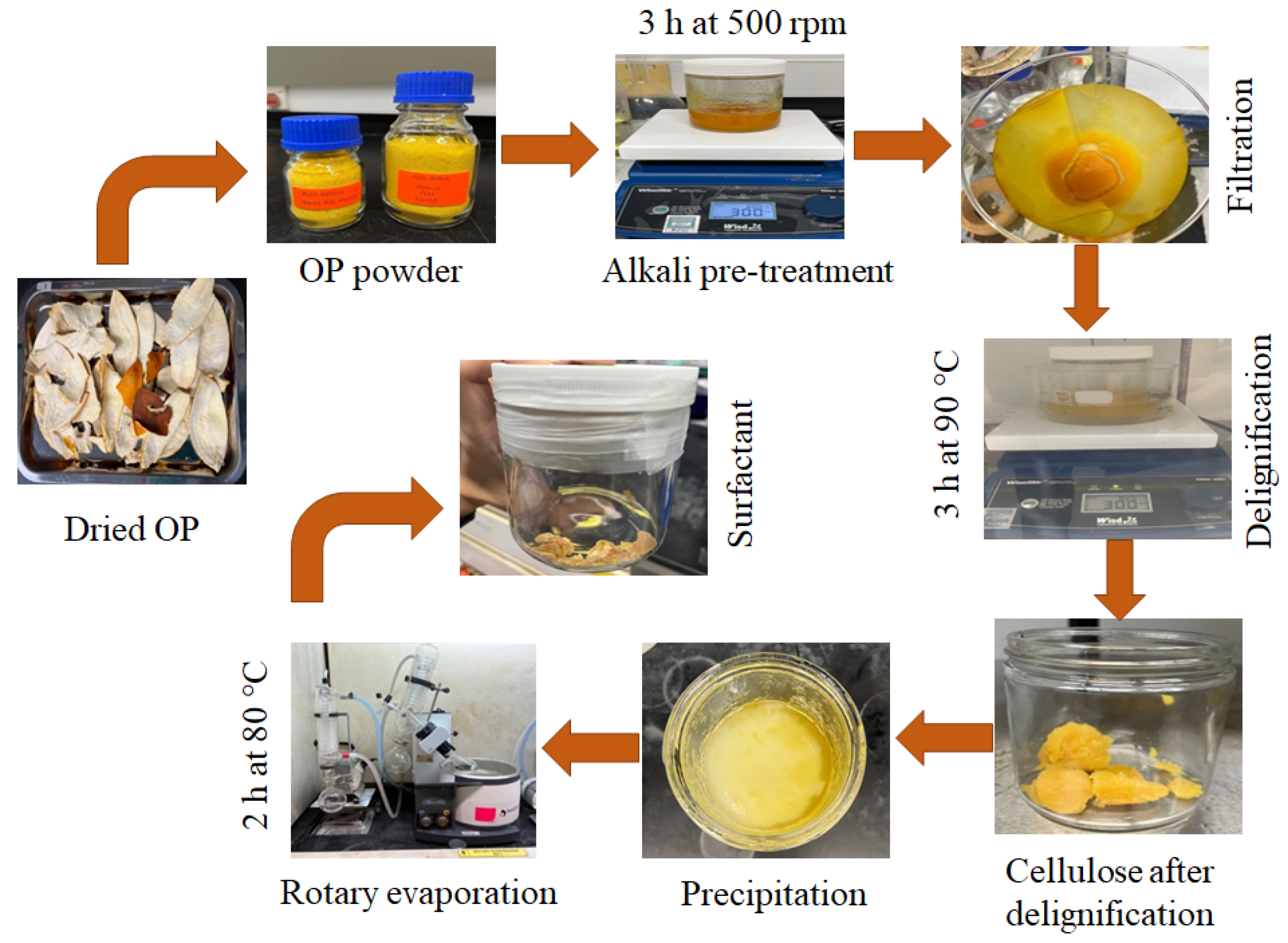
| DOR | Diameter (mm) | Average Diameter (mm) | ||
|---|---|---|---|---|
| 1 | 2 | 3 | ||
| SOPIL surfactant | ||||
| 1:100 | 0.653 | 0.254 | 0.558 | 0.489 |
| 1:50 | 0.175 | 0.230 | 0.601 | 0.335 |
| 1:25 | 0.230 | 0.143 | 0.421 | 0.265 |
| 1:1 | 0.090 | 0.125 | 0.207 | 0.141 |
| SOPOS surfactant | ||||
| 1:100 | 0.583 | 0.761 | 0.672 | 0.672 |
| 1:50 | 0.603 | 0.712 | 0.342 | 0.519 |
| 1:25 | 0.385 | 0.496 | 0.583 | 0.488 |
| 1:1 | 0.238 | 0.333 | 0.341 | 0.304 |
| Concentration (mg/L) | Number of Tested Fish | Number of Dead Fish (after 4 Days) | Mortality Percentage (%) |
|---|---|---|---|
| SOPIL surfactant | |||
| 100 | 10 | 0 | 0 |
| 200 | 10 | 0 | 0 |
| 300 | 10 | 0 | 0 |
| 400 | 10 | 0 | 0 |
| 500 | 10 | 0 | 0 |
| 600 | 10 | 0 | 0 |
| 700 | 10 | 0 | 0 |
| 800 | 10 | 0 | 0 |
| 900 | 10 | 0 | 0 |
| 950 | 10 | 0 | 0 |
| 1000 | 10 | 0 | 0 |
| SOPOS surfactant | |||
| 100 | 10 | 0 | 0 |
| 200 | 10 | 0 | 0 |
| 300 | 20 | 0 | 0 |
| 375 | 10 | 1 | 10 |
| 400 | 10 | 3 | 30 |
| 425 | 10 | 4 | 40 |
| 450 | 10 | 5 | 50 |
| 480 | 10 | 8 | 80 |
| 500 | 10 | 10 | 100 |
| Test Materials | R1 | R2 | R3 | R4 | %Biodegradation ± SD a |
|---|---|---|---|---|---|
| SOPIL | 77.27 | 79.32 | 82.72 | 83.25 | 80.64 ± 2.84 |
| SOPOS | 63.88 | 65.73 | 67.55 | 66.72 | 65.97 ± 1.58 |
| Reference b | 94.12 | 94.97 | 95.78 | 92.87 | 94.44 ± 1.24 |
Disclaimer/Publisher’s Note: The statements, opinions and data contained in all publications are solely those of the individual author(s) and contributor(s) and not of MDPI and/or the editor(s). MDPI and/or the editor(s) disclaim responsibility for any injury to people or property resulting from any ideas, methods, instructions or products referred to in the content. |
© 2023 by the authors. Licensee MDPI, Basel, Switzerland. This article is an open access article distributed under the terms and conditions of the Creative Commons Attribution (CC BY) license (https://creativecommons.org/licenses/by/4.0/).
Share and Cite
Wang, P.S.; Ahmad, A.; Nazar, M.; Rahmah, A.U.; Moniruzzaman, M. Biocompatible and Biodegradable Surfactants from Orange Peel for Oil Spill Remediation. Molecules 2023, 28, 5794. https://doi.org/10.3390/molecules28155794
Wang PS, Ahmad A, Nazar M, Rahmah AU, Moniruzzaman M. Biocompatible and Biodegradable Surfactants from Orange Peel for Oil Spill Remediation. Molecules. 2023; 28(15):5794. https://doi.org/10.3390/molecules28155794
Chicago/Turabian StyleWang, Peng Soon, Aqeel Ahmad, Masooma Nazar, Anisa Ur Rahmah, and Muhammad Moniruzzaman. 2023. "Biocompatible and Biodegradable Surfactants from Orange Peel for Oil Spill Remediation" Molecules 28, no. 15: 5794. https://doi.org/10.3390/molecules28155794





